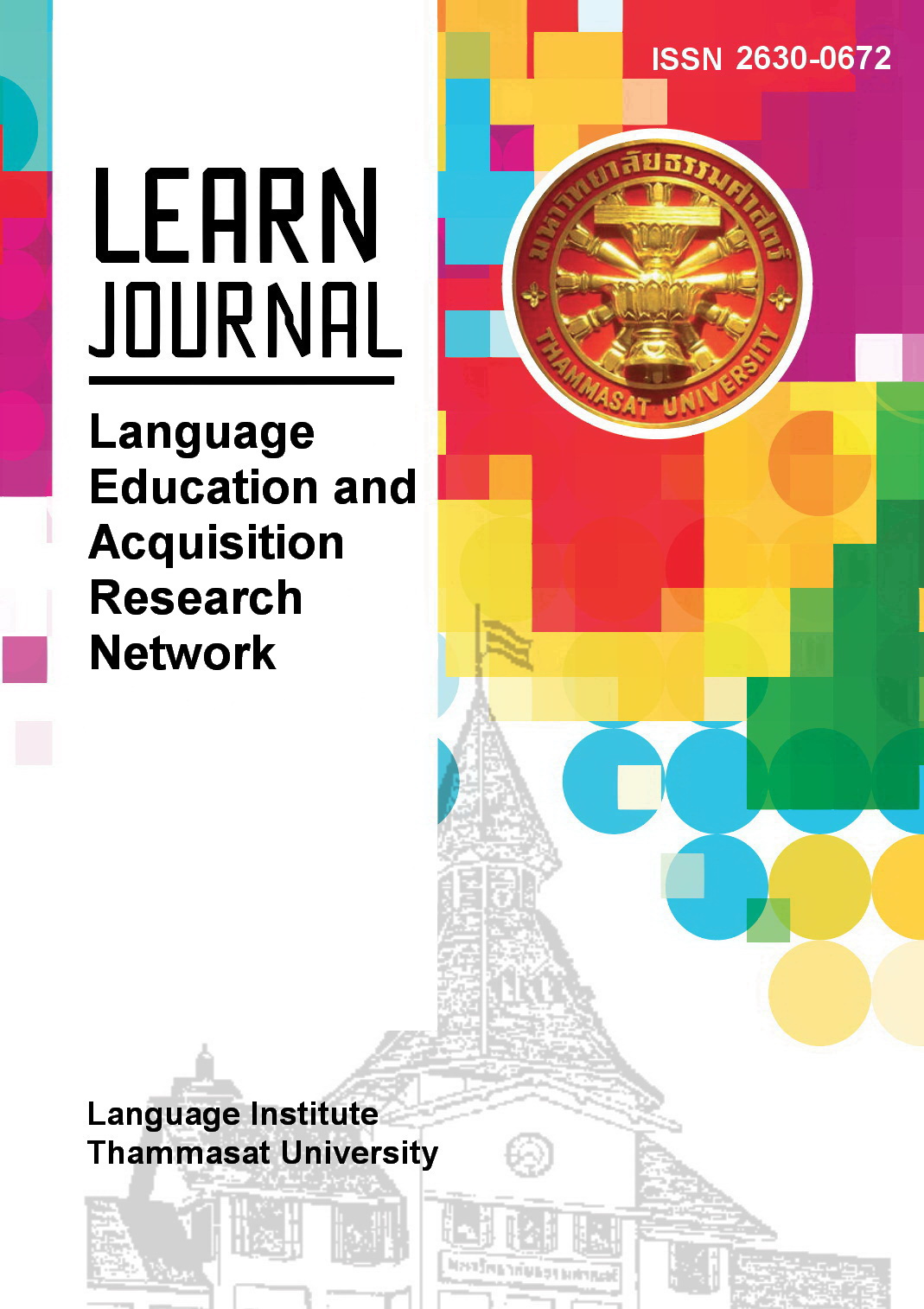How Do Art Critics Critique? A Move Analysis of Art Reviews Written by Professional Writers
Main Article Content
Abstract
The art review is a genre that describes the artwork under discussion, educates its readers, as well as interprets and evaluates the work. It is a genre that plays a crucial role in the art community as it publicizes art, promotes artists, educates the public and enhances their appreciation of art. This study investigates this underexplored genre through the move analysis of a 67,807-word corpus of 70 art review texts collected from online art magazines and online newspapers containing an art review section. The study reveals seven moves and seven steps found in the art reviews in the corpus: heading (Move 1), describing the work (Move 2), providing external information (Move 3), providing the artist’s background (Step 3.1), providing general knowledge (Step 3.2), discussing a past event that influences the work (Step 3.3), mentioning quotes (Step 3.4), mentioning other reviews (Step 3.5), interpreting the work (Move 4), judging the work (Move 5), providing evaluative comments (Step 5.1), recommending or disrecommending the work (Step 5.2), expressing general opinions and thoughts (Move 6), and sharing the writer’s personal experience (Move 7). The results also show no common move patterns, indicating that the genre allows fluidity and creativity in structuring the content.
Article Details
References
Ahmed, S. (2015). Rhetorical organization of tourism research article abstracts. Procedia – Social and Behavioral Sciences, 208, 269-281. DOI:10.1016/j.sbspro.2015.11.203
Alashari, D., & Hamzah, A. R. (2022). The role of Feldman's theory in art criticism: An analytical study, Jurnal Kemanusiaan, 19(1), 36–40. https://jurnalkemanusiaan.utm.my/index.php/kemanusiaan/article/view/414
Barnet, S. (2005). A short guide to writing about art (8th ed.). Pearson Longman.
Barrett, T. (2008). Criticizing art: Understanding the contemporary. Mayfield Publishing.
Bhatia, V. K. (1993). Analysing genre: Language use in professional settings. Longman.
Bhatia, V. K., & Han, Z. (2012, October). Comparative genre analysis of Chinese arbitration awards and litigation judgments. Retrieved from https://www.researchgate.net/publication/286882917_Comparative_genre_analysis_of_Chinese_legal_judgments_and arbitrationa
wards
Biber, D., Connor, U., & Upton, T. A. (2007). Discourse on the move: Using corpus analysis to describe discourse structure (Vol. 28). John Benjamins Publishing. https://doi.org/10.1075/scl.28
Bonyadi, A. (2012). Genre analysis of media texts. Procedia - Social and Behavioral Sciences, 66(7), 86-96. https://doi.org/10.1016/j.sbspro.
11.250
Brett, P. (1994). A genre analysis of the results section of sociology articles. English for Specific Purposes, 13(1), 47-59.
Carrier, D. (2022). Art writing online: The state of the art world. Cambridge Scholars Publishing.
Cretiu, A. (2002). Genre analysis: Art reviews in English. Studia Universitatis Babeş-Bolyai Philologia, 47(1-2), 69-75.
Damrongmanee, M. (2016). The artist statement as a genre: Move analysis with pedagogical aims. LEARN Journal: Language Education and Acquisition Research Network, 9(2), 83–104. https://so04.tci-thaijo.org/index.php/LEARN/article/view/102649/82196
Down, L. (2022, August 20). Five best ways to write an art review. Retrieved February 3, 2023, from https://artsartistsartwork.com/5-best-ways-to-write-an-art-review/
Feldman, E. B. (1992). Varieties of visual experience (4th ed.). Harry N. Abrams.
Feldman, E. B. (1994). Practical art criticism. Prentice Hall.
Flowerdew, J., & Wan, A. (2010). The linguistic and the contextual in applied genre analysis: The case of the company audit report. English for Specific Purposes, 29(2), 78-93. https://doi.org/10.1016/j.esp.2009.
001
Gao, S., & Pramoolsook, I. (2023). A cross-cultural move analysis of electronic engineering research article introductions: The case of Chinese, Thai, and native English scholarly writers. Ampersand, 10. https://doi.org/10.1016/j.amper.2022.100106
Hiranburana, K. (1996). Cross-cultural strategies and the use of English in international business correspondence. [Doctoral dissertation, Flinders University of South Australia]. http://cuir.car.chula.ac.th/handle/123456789/3375?src=/
handle/123456789/199/
Hocking, D. (2021). Artist’s statements, ‘how to guides’ and the conceptualisation of creative practice. English for Specific Purposes, 62, 103-116. https://doi.org/10.1016/j.esp.2020.12.006
Holmes, R. (1997). Genre analysis, and the social sciences: An investigation of the structure of research article discussion sections in three disciplines. English for Specific Purposes, 16(4), 321–337. https://doi.org/10.1016/S0889-4906(96)00038-5
Hyland, K. (2004). Genre and second language writing. University of Michigan Press.
Hyland, K. (2007). Genre pedagogy: Language, literacy and L2 writing instruction. Journal of Second Language Writing, 16(3), 148–164. https://doi.org/10.1016/j.jslw.2007.07.005
IESA Art & Culture. (n.d.). Art critic: Job description. Retrieved on February 20, 2023, from https://www.iesa.edu/paris/news-events/art-critic
Işık, E. E. (2023). A corpus-based genre analysis of promotional informational discourse in online painting exhibition overviews. English for Specific Purposes, 70, 44–56. https://doi.org/10.1016/j.esp.2022.11.002
Jirapanakorn, N. (2013). A move analysis of English medical research articles published in Thai and international medical journals. (Master’s thesis, King Mongkut’s University of Technology Thonburi). Digital Research Information Center. https://doi.nrct.go.th/ListDoi/listDetail?Resolve
_DOI=10.14457/KMUTT.the.2013.97
Kanoksilapatham, B. (2005). Rhetorical structure of biochemistry research articles. English for Specific Purposes, 24(3), 269–292. https://doi.org/10.1016/j.esp.2004.08.003
Kanoksilapatham, B. (2015). Distinguishing textual features characterizing structural variation in research articles across three engineering sub-discipline corpora. English for Specific Purposes, 37, 74-86. https://doi.org/10.1016/j.esp.2014.06.008
Kay, H., & Dudley-Evans, T. (1998). Genre: What teachers think. ELT Journal, 52(4), 308-314. https://doi.org/10.1093/elt/52.4.308
Maswana, S., Kanamaru, T., & Tajino, A. (2015). Move analysis of research articles across five engineering fields: What they share and what they do not. Ampersand, 2, 1-11. https://doi.org/10.1016/j.amper.2014.12.002
Ntone, N. (2019, February 3) Why art criticism is important? Retrieved February 2, 2023, from https://natashantone.com/home/2019/2/
/why-art-criticism-is-important
Nwogu, K. N. (1997). The medical research paper: Structure and functions. English for Specific Purposes, 16(2), 119–138. https://doi.org/10.1016/S0889-4906(97)85388-4
Panseeta, S., & Watson Todd, R. (2014). A genre analysis of 5-star hotels’ responses to negative reviews on TripAdvisor. rEFLections, 18, 1-13.
Posteguillo, S. (1999). The schematic structure of computer science research articles. English for Specific Purposes, 18(2), 139–160. https://doi.org/10.1016/S0889-4906(98)00001-5
Rau, G., & Shih, Y.-S. (2021). Evaluation of Cohen’s kappa and other measures of inter-rater agreement for genre analysis and other nominal data. Journal of English for Academic Purposes, 53. https://doi.org/10.1016/j.jeap.2021.101026
Rojanaatichartasakul, S., & Phoocharoensil, S. (2022). Move structures and stance adverbials in editorials from The Bangkok Post and The New York Times. rEFLections, 29(2), 454–474. https://so05.tci-thaijo.org/index.php/reflections/article/view/260802
Swales, J. M. (1990). Genre analysis: English in academic and research settings. Cambridge University Press.
Swales, J. M. (2016). Configuring image and context: Writing ‘about’ pictures. English for Specific Purposes, 41, 22–35. https://doi.org/10.1016/j.esp.2015.08.003
Vaughan, E., & Clancy, B. (2013). Small corpora and pragmatics. Springer.
https://doi /10.1007/978-94-007-6250-3_4
Writing art reviews. (n.d.) Retrieved from https://www.ocadu.ca/Assets/content/teaching-learning/WLC/Online+Resources/Writing+Art+Reviews.pdf


